- What is the role of aluminum foil in air conditioning systems?
- Aluminum Foil For Air Conditioner Specification
- Typical Air Conditioner Aluminum Foil Introduction
- Kinds of Aluminum Foil For Air Conditioner
- Air Conditioner Aluminum Foil Mechanical Properties
- Air Conditioner Aluminum Foil Chemical Composition
- Main technical indicators of non-coated air conditioner aluminum foil
- Main technical indicators of coated air conditioner aluminum foil
- Specific Application of Aluminum Foil in Air Conditioners
- Frequently Asked Questions About the Air Conditioner Aluminum Foil
What is the role of aluminum foil in air conditioning systems?
Aluminum foil is used in air conditioning systems for various purposes, including enhancing heat transfer efficiency, preventing corrosion, providing insulation, managing moisture, and improving overall system performance.
There are several types of aluminum foil used in air conditioning, including:
- Bare Aluminum Foil
- Hydrophilic Aluminum Foil
- Hydrophobic Aluminum Foil
- Epoxy-coated Aluminum Foil
- Pre-coated Aluminum Foil
- Laminated Aluminum Foil
Each type serves a specific purpose in improving different aspects of air conditioning components.
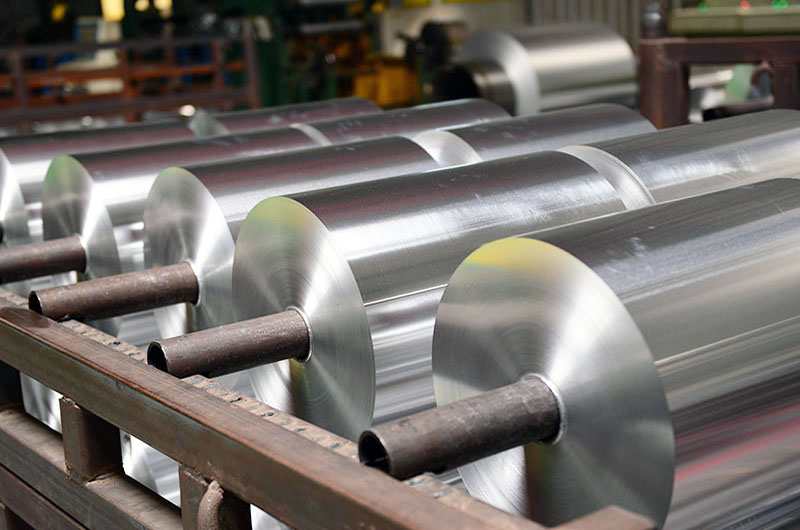
When using aluminum foil for air conditioners, it is important to use the correct thickness and grade of aluminum foil for the specific application. Thicker foils may be required for insulation purposes, while thinner foils may be used for winding coils or for other purposes. It is also important to ensure that the foil is properly installed and sealed to prevent air leakage or damage to the equipment.
Aluminum foil can be a useful tool in improving the performance and efficiency of air conditioning systems, but it should be used with caution and with the proper expertise to ensure the best results.
Aluminum Foil For Air Conditioner Specification
| Product Name | Air Conditioner Aluminum Foil |
| Alloy | 1100 1200 3102 8011 |
| Temper | H22 H24 H26 |
| Thickness | 0.02-0.05mm |
| Width | 200-1450mm |
| Length/Weight | Customized |
| Inner Diameter | 76mm or 152mm |
Typical Air Conditioner Aluminum Foil Introduction
1100/1200 Air Conditioner Aluminum Foil
- Application : Mainly used in heat exchangers and evaporators in air conditioning systems.
- Unique advantages : high strength, good machinability, good corrosion resistance, not easy to deform.
- Thickness : generally 0.1-0.3mm.
- Processing : During the processing, it is necessary to maintain a certain temperature and humidity to avoid the influence on the aluminum foil.
1100 air-conditioning aluminum foil and 1200 air-conditioning aluminum foil have a certain overlap in application, but because 1200 alloy is slightly harder, it may be more suitable in some occasions that require higher hardness.
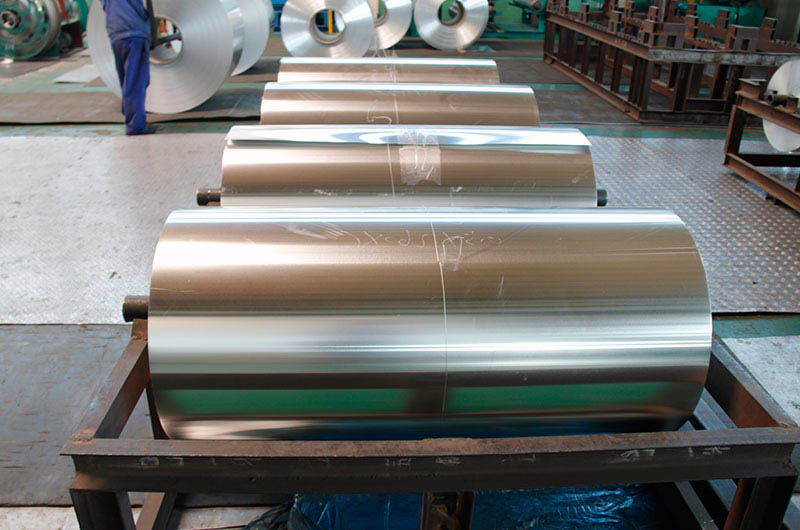
8011 O H22 H24 Air Conditioner Aluminum Foil
8011 aluminum foil is used for refrigerant pipe/housing, 1100 and 1200 are mainly used for heat exchanger and evaporator.
- Application : Mainly used for refrigerant pipes in air-conditioning systems and casings of outdoor air-conditioning units.
- Unique advantages : good machinability, high strength, good corrosion resistance, good sealing performance, and easy molding.
- Thickness : generally 0.08-0.2mm.
- Processing : 8011 air-conditioning aluminum foil is soft, easy to shape and process. During the processing, it is necessary to maintain a certain temperature and humidity to avoid the influence on the aluminum foil.
3102 H26 Aluminum Foil for Air Conditioners
3102 H26 aluminum foil is specifically designed for use on condenser and evaporator fins in air conditioning systems. These fins are crucial for efficient heat exchange within the unit. The H26 temper signifies that the foil has undergone strain hardening and is in a fully hardened state, enhancing its mechanical strength and durability. This foil is chosen for its ability to efficiently dissipate heat, crucial for maintaining optimal performance and energy efficiency in air conditioners.
8006 O H22 Aluminum Foil for Air Conditioners
8006 O H22 aluminum foil is widely utilized in air conditioning systems, particularly for crafting pipes, connectors, and other components. The O temper indicates it is annealed to achieve maximum ductility, while H22 further denotes a partially hardened condition for improved strength and formability. This foil is valued for its excellent malleability and bendability, allowing it to be easily formed into intricate shapes required for various air conditioning components. It ensures reliable performance and longevity in demanding HVAC environments.
4343/3003/4343 Composite Aluminum Foil
This composite aluminum foil combines layers of 4343 alloy, 3003 alloy, and another layer of 4343 alloy. It is renowned for its superior corrosion resistance and excellent weldability, making it ideal for manufacturing radiator fins in air conditioning units. The foil's composition and structure enable it to withstand the harsh conditions of cooling systems, effectively transferring heat while maintaining durability over extended periods. It is commonly used in general-purpose air conditioner radiators and coolers where reliability and efficiency are paramount.
4343/3003/4045 Composite Aluminum Foil
Comprising layers of 4343 alloy, 3003 alloy, and 4045 alloy, this composite aluminum foil offers exceptional corrosion resistance and superior welding characteristics. It is specifically tailored for high-performance cooling systems and radiators in air conditioners, where reliability under demanding conditions is critical. The foil's composition ensures optimal heat dissipation and structural integrity, contributing to the efficiency and longevity of advanced air conditioning units.
1100, 1200, and 8011 air-conditioning aluminum foils all have good corrosion resistance, processability and formability, but they are different in application.
Kinds of Aluminum Foil For Air Conditioner
Aluminum foil commonly used in air conditioning systems
Bare Aluminum Foil
Bare Aluminum Foil : This is plain aluminum foil without any coating or surface treatment.
- Application: Wrapping air conditioning coils or for insulation purposes.
- Alloy and Temper: Typically, alloys like 1100 or 1200 in the O temper (annealed) are commonly used.
- Advantages: Cost-effective, basic protection for coils and insulation.
- Disadvantages: Limited protection against corrosion and moisture.
Hydrophilic Aluminum Foil
Hydrophilic Aluminum Foil : This aluminum foil has a special coating that makes it highly absorbent. It is commonly used in air conditioning fins and coils as it helps improve heat transfer and prevents corrosion.
- Application: Air conditioning fins and coils to improve heat transfer and prevent corrosion.
- Alloy and Temper: Usually alloys like 8011, H24 temper (semi-hard) are used.
- Advantages: Improved heat transfer, corrosion prevention, efficient moisture drainage.
- Disadvantages: Hydrophilic coatings can wear over time, requiring maintenance.
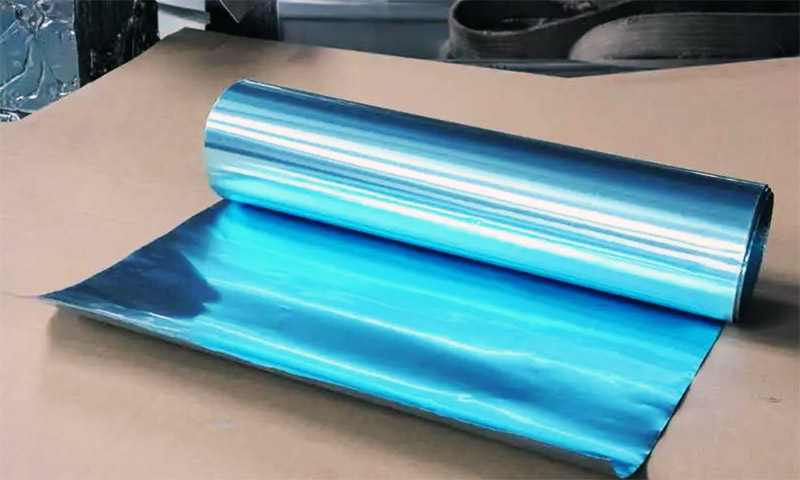
Hydrophobic Aluminum Foil
Hydrophobic Aluminum Foil : Hydrophobic aluminum foil refers to aluminum foil that has been treated or coated with a hydrophobic (water-repellent) substance or material. This treatment changes the surface properties of the foil, causing water to bead up and roll off the surface instead of wetting and spreading out.
- Application: Prevents water accumulation on various air conditioning components.
- Alloy and Temper: Similar alloys as hydrophilic foil, often 8011, H24 temper.
- Advantages: Prevents water-related issues, corrosion resistance, improves system efficiency.
- Disadvantages: May wear over time, effectiveness can vary based on conditions.
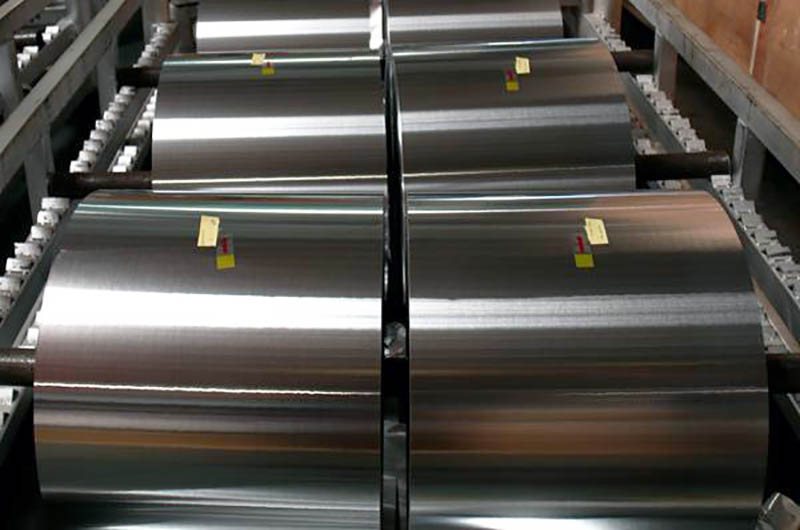
Epoxy-Coated Aluminum Foil
Epoxy-coated aluminum foil : This type of aluminum foil has a special epoxy coating that helps increase durability and prevent corrosion. It is commonly used in air conditioning ducts and panels.
- Application: Used in air conditioning ducts and panels for durability and corrosion prevention.
- Alloy and Temper: Typically alloys like 3003, H22 or H24 temper.
- Advantages: Increased corrosion resistance, enhanced durability.
- Disadvantages: Potential for cracking or chipping of epoxy coating under stress.
Pre-Coated Aluminum Foil
Pre-coated aluminum foil : This foil has a pre-coated coating, such as a thermosetting resin or heat-activated adhesive. It is often used in air conditioning ducts as it helps with insulation and prevents air leaks.
- Application: Air conditioning ducts for insulation and preventing air leaks.
- Alloy and Temper: Often 1100, 1200 or 8011, with a variety of tempers depending on the specific coating.
- Advantages: Enhanced insulation, reduced air leakage, protection against condensation.
- Disadvantages: Coating may degrade over time, affecting performance.
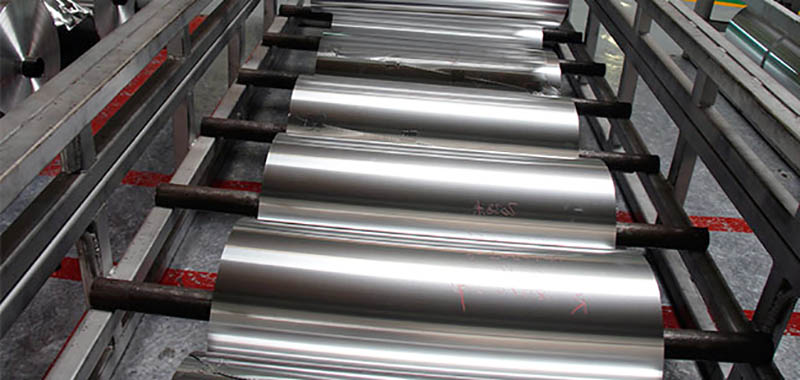
Laminated Aluminum Foil
Laminated Aluminum Foil: This foil is made by laminating two or more layers of foil together with a layer of adhesive. It is commonly used in air conditioning systems to provide insulation and improve heat transfer efficiency.
- Application: Used for insulation and improved heat transfer efficiency in air conditioning systems.
- Alloy and Temper: Multiple alloys can be used, often chosen based on required characteristics.
- Advantages: Enhanced insulation, improved heat transfer efficiency, customization options.
- Disadvantages: Thicker material may affect space constraints, requires careful lamination.
The choice of alloy, temper, and type of aluminum foil depends on the specific requirements of the air conditioning system, including environmental conditions, desired performance characteristics, and budget considerations. Each type of foil offers distinct advantages and potential drawbacks, so manufacturers must carefully assess their needs to determine the most suitable option for their particular application.
The specific type of aluminum foil used in an air conditioning system will depend on the specific requirements of the system and the environment in which it is installed.
Air Conditioner Aluminum Foil Mechanical Properties
| Alloy | Temper | Thickness(Mm) | Width (Mm) | I.D.(Mm) | Mechanical Properties | ||
| Tensile Strength (Mpa) | Elongation(%) | Erichson (IE, Mm | |||||
| 1100 1200 3102 8011 8006 | O | 0.08-0.2 (+/-5%) | 100-1400 (+/-1) | 75/150/ 200/300/505 | 80-110 | ≥27 | ≥6.0 |
| H22 | 100-135 | ≥22 | ≥5.5 | ||||
| H24 | 115-145 | ≥20 | ≥5.0 | ||||
| H26 | 125-160 | ≥10 | ≥4.5 | ||||
| H18 | ≥160 | ≥1 | – | ||||
| Special Specifications Can Be Produced As Per Customer’s Requirements | |||||||
Air Conditioner Aluminum Foil Chemical Composition
| Alloy | Si | Fe | Cu | Mn | Mg | Cr | Zn | Ni | Ti | Other | Al | |
| Each | Total | |||||||||||
| AA1200 | 1.00 | 0.05 | 0.05 | – | – | 0.10 | 0.05 | 0.05 | 0.15 | 99.00 | ||
| AA3102 | 0.40 | 0.70 | 0.10 | 0.05-0.4 | – | – | 0.30 | 0.10 | 0.05 | 0.15 | Rest | |
| AA8011 | 0.5-0.9 | 0.6-1.0 | 0.10 | 0.20 | 0.05 | 0.05 | – | 0.10 | 0.08 | 0.15 | Rest | |
| AA8006 | 0.40 | 1.2-2.0 | 0.30 | 0.3-1.0 | 0.10 | – | 0.10 | 0.10 | 0.05 | 0.05 | 0.15 | Rest |
Main technical indicators of non-coated air conditioner aluminum foil
- Chemical composition: The main alloy grades of air-conditioning aluminum foil are 1100, 1200, 8011, etc. The choice of alloy depends on the final mechanical properties and ease of processing. For example, 1100 aluminum alloy is easy to roll, while 8011 alloy is more difficult.
- Mechanical Properties: Relates to tensile strength, elongation and cupping values. These three indicators are contradictory to each other, and the intermediate value is usually taken in practical applications. The mechanical performance requirements depend on the processing method of the heat exchanger fins, which are divided into stretched and non-stretched types, each with different requirements.
- Usage status: The usage status of aluminum foil is H22, H24, H26, corresponding to different strength and plasticity.
Main technical indicators of coated air conditioner aluminum foil
The main technical indicators of coated air-conditioning aluminum foil include plate shape, coating performance, coating thickness, coating adhesion, hydrophilic performance and corrosion resistance.
- Plate shape: A prerequisite for measuring the production process of coated aluminum foil, which requires good plate shape.
- Coating performance: For hydrophilic aluminum foil, coating performance includes coating thickness, coating adhesion, hydrophilic performance and corrosion resistance.
- Coating thickness: Control it below 3/1m, which affects various performance indicators of the coating.
- Coating adhesion: It represents the firmness of the coating and the aluminum foil, which affects the stability of the product during processing and use.
- Hydrophilic property: Measures the affinity of the aluminum foil surface to water, evaluated by the contact angle (a angle).
- Corrosion resistance: Including alkali resistance, salt spray corrosion resistance and moisture and heat resistance, which are directly related to the service life and weather resistance of the product.
These indicators play a key role in the production and application of coated air conditioning aluminum foil, affecting the performance and quality of the product.
Specific Application of Aluminum Foil in Air Conditioners
The thickness and size of the foil will depend on the specific application and requirements of the air conditioning system. The general thickness is 0.05mm ~ 0.2mm, and the width can reach hundreds of millimeters.
During processing, aluminum foil may undergo several special treatments, such as surface treatment to enhance its corrosion resistance and adhesion, and rolling or annealing to achieve the desired mechanical properties.
Application Field of Aluminum Foil in Air Conditioning Ssystem
- Evaporator : Use plain aluminum foil to enhance heat transfer. Foil is often made in thin sheets and corrugated to increase surface area and improve heat transfer.
- Condenser : Hydrophilic aluminum foil is used to improve heat transfer efficiency and reduce energy consumption. This type of foil has a special surface treatment that makes it highly hydrophilic, meaning it absorbs and diffuses water quickly and evenly.
- Heat Exchangers : Aluminum foil can be used as a component in heat exchangers to improve heat transfer between two fluids.
Main Products of Aluminum Foil for Air Conditioner
- Air Conditioning Foil Tape : This is a type of tape specially designed for sealing and joining sections of air conditioning ducts. It is made of aluminum foil coated with an acrylic or rubber adhesive.
- Aluminum foil for air-conditioning ducts : This aluminum foil is used for insulation and protection of air-conditioning ducts. It is usually thicker and more durable than regular aluminum foil.
- Aluminum foil for air conditioner fins : This aluminum foil is used to wrap air conditioner fins to increase their efficiency and prevent damage. It is usually thinner than piping foil. (fin material aluminum fin stock)
- Aluminum foil for air conditioning coils : This aluminum foil is used to wrap air conditioning coils to improve heat transfer and prevent corrosion. It is usually thinner and more flexible than piping foil. (microchannel tube)
- Aluminum foil for air conditioner panels : This aluminum foil is used to cover and protect air conditioner panels. It is usually thicker and more durable than regular aluminum foil.
The specific product used will depend on the type and size of the air conditioning system and the specific requirements for insulation, protection and efficiency
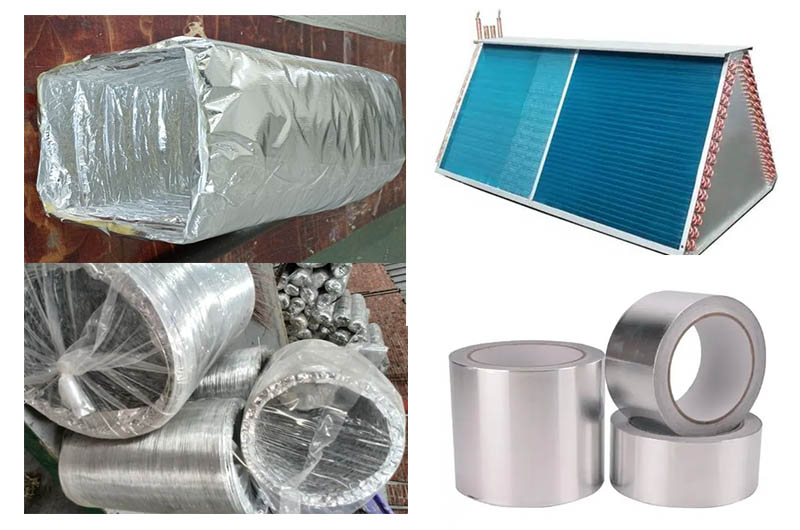
Frequently Asked Questions About the Air Conditioner Aluminum Foil
1. What are hydrophilic and hydrophobic coatings on aluminum foil?
Hydrophilic coatings make aluminum foil absorbent, aiding in heat transfer and moisture management. Hydrophobic coatings repel water, preventing water absorption and promoting water droplet beading.
2. What advantages does hydrophilic aluminum foil offer in air conditioning systems?
Hydrophilic foil enhances heat transfer efficiency, improves moisture drainage, and prevents corrosion on fins and coils.
3. How does laminated aluminum foil improve heat transfer efficiency?
Laminated foil consists of multiple layers with adhesive in between. It provides enhanced insulation and improved heat transfer efficiency, helping to optimize air conditioning system performance.
4. What maintenance is required for hydrophilic and hydrophobic coatings?
Hydrophilic and hydrophobic coatings can wear over time due to environmental factors. Regular inspection and, if necessary, reapplication of coatings may be needed.
5. Can aluminum foil be recycled from old air conditioning components?
Yes, aluminum foil from old air conditioning components can be recycled. Aluminum is highly recyclable and can be used to produce new foil and other aluminum products.
